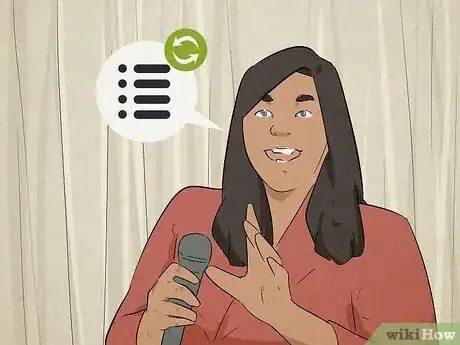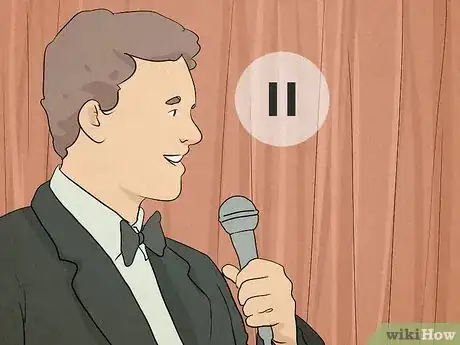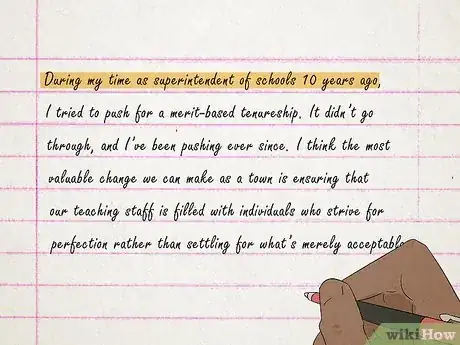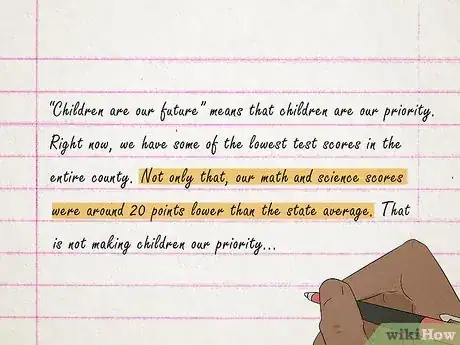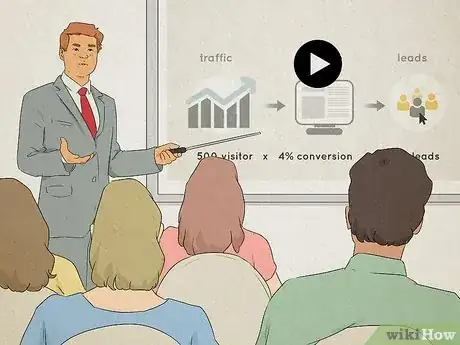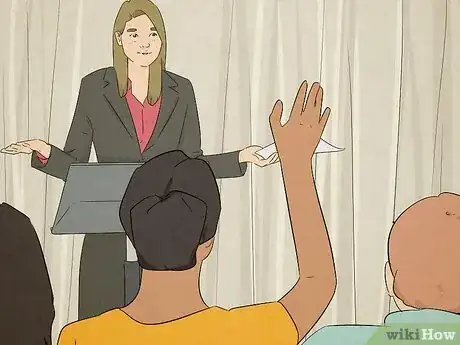This article was co-authored by Lynn Kirkham and by wikiHow staff writer, Aly Rusciano. Lynn Kirkham is a Professional Public Speaker and Founder of Yes You Can Speak, a San Francisco Bay Area-based public speaking educational business empowering thousands of professionals to take command of whatever stage they've been given - from job interviews, boardroom talks to TEDx and large conference platforms. Lynn was chosen as the official TEDx Berkeley speaker coach for the last four years and has worked with executives at Google, Facebook, Intuit, Genentech, Intel, VMware, and others.
There are 7 references cited in this article, which can be found at the bottom of the page.
This article has been viewed 7,322 times.
When you’re giving a speech, it often feels like it happened in a flash—so what do you do if you need to slow things down? Adding length to a speech is something many speakers and presenters have to do, and, thankfully, they’ve provided quite a few tips. In this article, we’ll share with you the best tricks to make any presentation longer.
Things You Should Know
- Prioritize speaking slowly and clearly, and state your key points multiple times throughout your speech.
- Add length by including stories, examples, facts, and quotes in your speech to back up your main points.
- Use a visual aid like a powerpoint or a handout to add time and audience engagement.
Steps
Speak slowly and clearly.
-
Enunciate your words so the audience can understand you. Not only does this help you get your message across, but it also lengthens your speech time. Think of it like you’re talking to an older relative. You don’t want to be a robot, but you want the audience to be able to hear and understand each word.
- Try not to sacrifice enthusiasm for speed.[1] X Trustworthy Source American Psychological Association Leading scientific and professional organization of licensed psychologists Go to source You can still be ecstatic and passionate while speaking clearly.
Repeat your important points.
-
Emphasize your key points to keep the audience engaged. There’s no shame in repetition when it comes to giving a presentation. You have some very important things to say, so don’t shy away from repeating, summarizing, or recapping them! If something you’ve said is especially crucial, try saying the sentence again with a different tone or emphasis.
- Although repetition is good, try to avoid repeating things back to back. This could tire out your audience.
- Key ideas and themes are great words and phrases to recap throughout.
- An excellent example of repetition is Dr. Martin Luther King, Jr.’s I Have a Dream, where he reiterates the famous lines, “I have a dream that my four little children will…I have a dream that one day on the red hills of Georgia…I have a dream today!”[2] X Research source
Pause for dramatic effect.
-
Add a couple of seconds with a calculated breath or pause. Do you ask a rhetorical question during your speech? Do you state a mind-blowing fact? After these moments, take a second or two to pause, giving the audience time to reflect on what you’ve said.[3] X Research source
- Think of your speech as a performance. If it were a play or movie, where would you see a dramatic pause?
- Count out your pause in your head or tap your finger at your side.
- Emphasize your pause by saying something like, “Now, think about that.”
- Mark in your speech where you’d like to pause dramatically. This will help you while practicing and can be a physical reminder during your speech if you're using cue cards.
Add an extra story or example to your speech.
-
Give your speech length by having more to talk about. Storytelling is one of the best techniques you can use when writing a speech; it helps people remember what you have to say, and it takes up minutes of your time.[4] X Research source If your speech is too short, consider throwing in another story or example the audience can relate to.
- Write your story out on paper outside of your speech to flesh it out.[5] X Research source
- The story or example doesn’t have to be personal. It could be a metaphor, allegory, or even a reiteration of a well-known tale.
- Make your story extra dynamic by tapping into the feelings and senses of the moment. What was the weather like? Was there air blowing into the open window? Make your story as descriptive as you can so it sounds rich and interesting.
Use facts and quotes in your speech.
-
Read off meaningful quotes and statistics for extra time and credibility. Now, reading off a quote that’s a paragraph long may be excessive, but a line here and there can do wonders to your time. Toss in some fun facts or knowledgeable quotes to support your key points.
- If you’re directly quoting someone else, say “quote” before stating the quote and “unquote” after the quote’s final word.
Connect with the audience during your speech.
-
Speaking to your audience can inspire you to keep talking.[6] X Trustworthy Source American Psychological Association Leading scientific and professional organization of licensed psychologists Go to source Showing rapport with your audience doesn’t just mean talking about a topic of interest or making eye contact; it can also mean interacting with the audience. Take time during your speech to engage with your audience by asking questions or starting a fun activity.
- Ask members of the audience to raise their hands if they’ve done X, Y, or Z.
- Toss in an energizing stretch break or audience-participation activity during the middle of your speech (this is great for a younger audience).
- Practice audience connection techniques in front of friends or family to test what works best for your speech.
Sync a slide presentation to your speech.
-
Using mixed media can add energy and vibrancy to your speech.[7] X Trustworthy Source American Psychological Association Leading scientific and professional organization of licensed psychologists Go to source Create a slideshow that goes along with your main points that features pictures, videos, music, and/or quotes. This can help keep your audience engaged and following along.
- Make sure to practice with your slideshow before presenting your speech, noting when you need to click over to another slide.
- Try to avoid reading directly from the slides. Your speech should already explain what’s on the screen.[8] X Research source
Play a video during your speech.
-
Inserting a video clip gives you a talking break while adding on minutes. Many speakers and presenters add length to their speeches by using multimedia. A 2- to 5-minute video will keep the clock ticking and further engage the audience.[9] X Trustworthy Source Harvard Business Review Online and print journal covering topics related to business management practices Go to source
- Pick a video that has something to do with your speech. You want the video to add to your speech, not take away from it.
- Place your video at a point in your presentation where it’s natural. For example, don’t stop in the middle of a story to show the video version of what you’re describing. Play the video before or after you’ve said something important.
Walk around while giving your speech.
Time your speech while you practice and present.
-
Ease nerves by effectively pacing yourself before and during the speech. Talking fast is natural when giving a speech. It’s estimated that a speaker’s pace increases by 10 to 20% during a presentation.[10] X Research source Because of this, it’s imperative to time yourself while you practice, estimating that your delivery will be roughly a minute or two faster when you actually give the speech.
- Practice your speech using different rhythms and pauses, and note what helps you stretch the time without awkward pauses.
Give the audience a handout during your speech.
-
Stall for time by offering a tangible and reliable reference. This can be a handout featuring your key points, tips, a graph, or a chart.[11] X Research source Taking the time to pass out papers can add a few extra seconds to your speech.
- Try to walk and talk while you do this, so there isn’t an awkward silence drawing out the time.
- Hand out your resource during a lull in your speech or towards the end before a Q&A.
Take questions from the audience.
-
Give listeners a chance to encourage you to say more. Who doesn’t love a good Q&A session? If your speech runs a bit short, no problem! Take the rest of your allotted time to answer questions from the audience.[12] X Trustworthy Source American Psychological Association Leading scientific and professional organization of licensed psychologists Go to source
- Aim for leaving about 15 minutes at the end of your presentation for questions.
- Try bringing up your key points again if no one has any questions right away.
You Might Also Like
 How to Deliver a Thank You Speech for an Award or Special Occasion
How to Deliver a Thank You Speech for an Award or Special Occasion




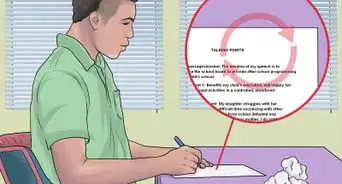








References
- ↑ https://www.apa.org/monitor/2017/02/tips-speaking
- ↑ https://www.agnesscott.edu/center-for-writing-and-speaking/repetition.html
- ↑ https://mannerofspeaking.org/2019/11/12/pauses-in-a-speech-why-when-and-how/
- ↑ https://www.entrepreneur.com/article/316145
- ↑ https://www.entrepreneur.com/article/316145
- ↑ https://www.apa.org/monitor/2017/02/tips-speaking
- ↑ https://www.apa.org/monitor/2017/02/tips-speaking
- ↑ https://www.fau.edu/honors/undergraduate-research/documents/general-guidelines.pdf
- ↑ https://hbr.org/2013/06/how-to-give-a-killer-presentation
About This Article


